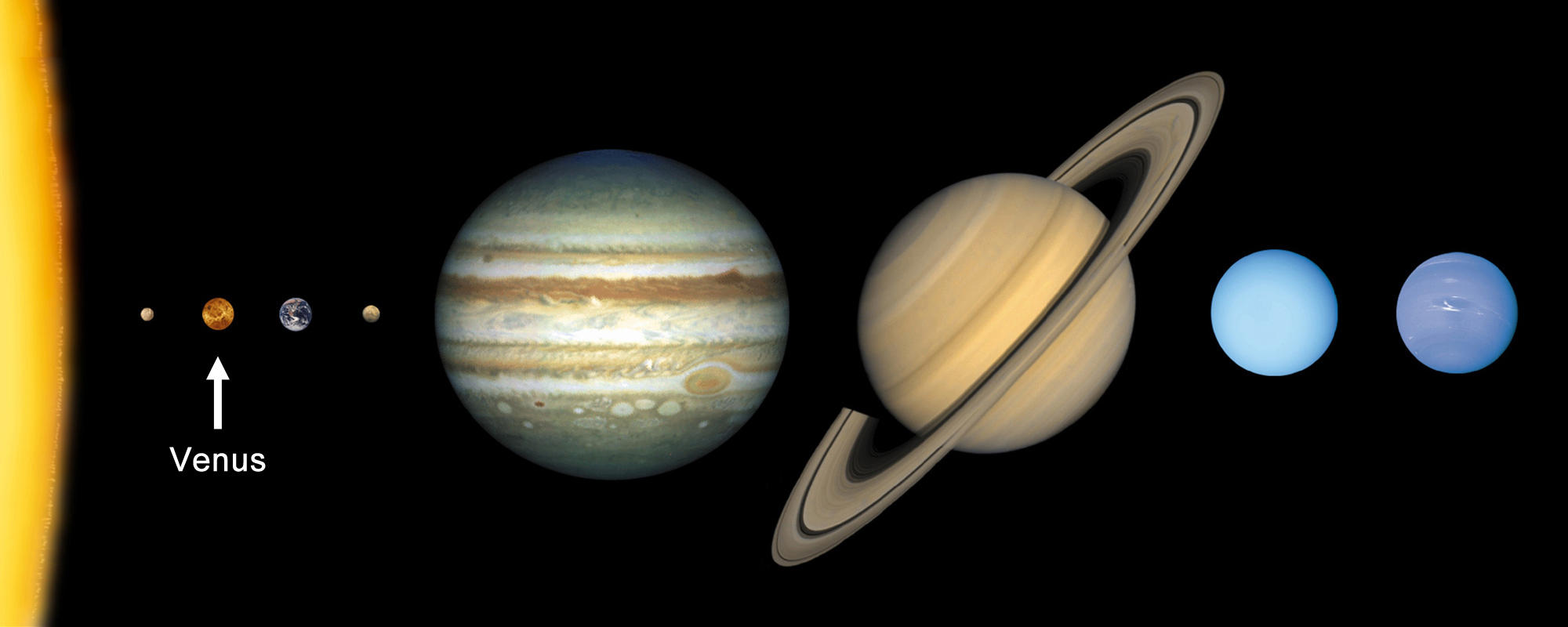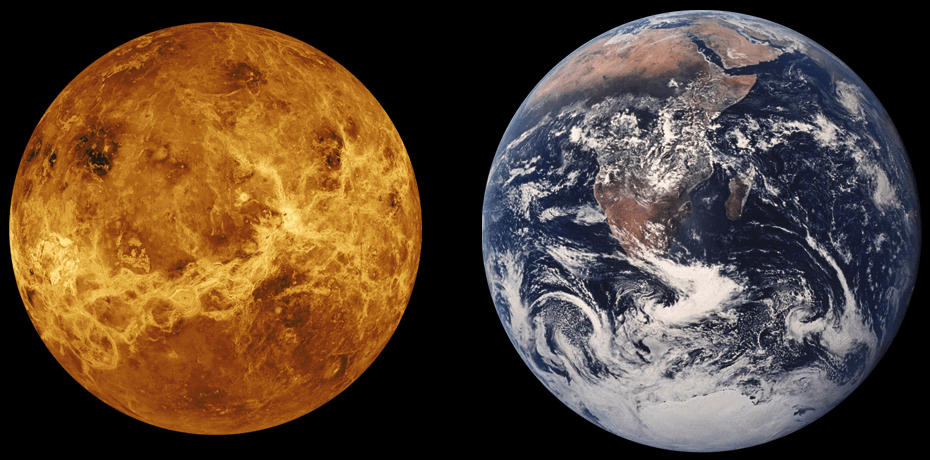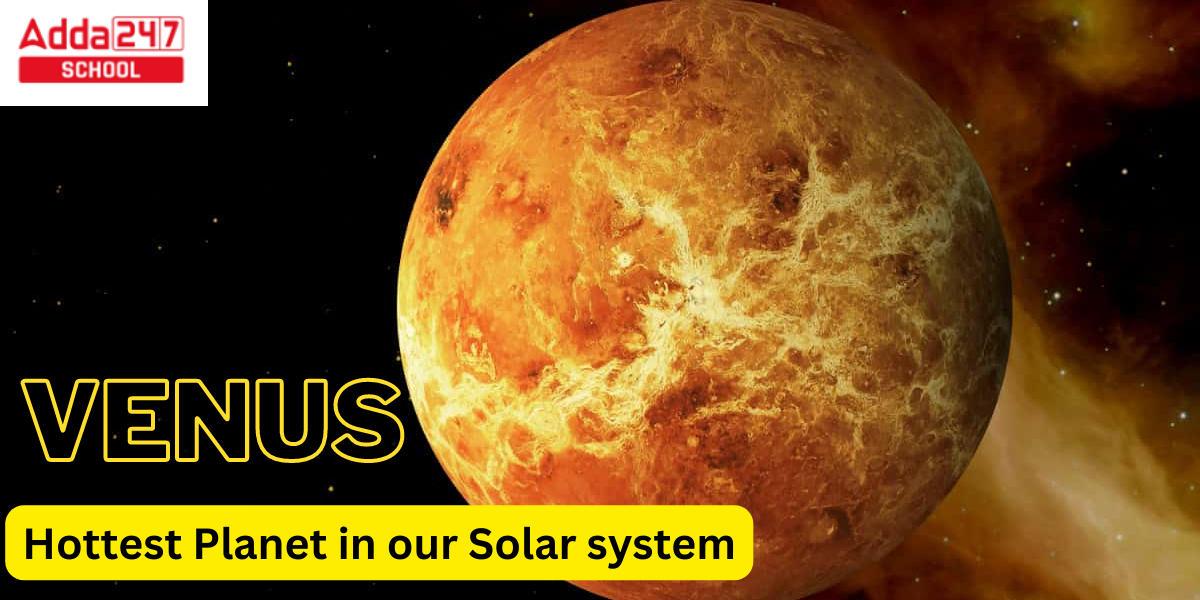Hottest Planet in Solar System
The hottest planet in the solar system is Venus, Let’s check all facts about Venus. Venus is the hottest planet in our solar system, with surface temperatures hot enough to melt lead due to the runaway greenhouse effect caused by its thick atmosphere, which traps heat. hottest planet in the solar system is about 700°F (390°C) hotter than it would be in the absence of the greenhouse effect. Thick, poisonous sulfuric acid clouds that cover Venus permanently begin at an altitude of 28 to 43 miles (45 to 70 kilometers). the hottest planet in solar system clouds has a rotten egg odor.
Hottest Planet in Solar System: Position of Venus
The second planet from the Sun is Venus. hottest planet in the solar system is sometimes referred to as Earth’s “twin” or “sister” planet because it is nearly as big and comparable in makeup. Like Mercury, Venus is an inner planet to Earth and is always close to the Sun when it appears in the night or morning sky. Venus is the brightest natural object in Earth’s sky other than the Sun and Moon; hottest planet in solar system may create visible shadows on Earth in low light and can be seen with the unaided eye in brilliant sunlight.

Hottest Planet in the Solar System: Size of Venus
The second-largest terrestrial object in the solar system is called Venus. hottest planet in the solar system has a weakly induced magnetosphere and a surface gravity that is slightly lower than that of Earth. Venus has the densest and warmest atmosphere of the four terrestrial planets at its surface. Venus’ atmosphere is primarily composed of carbon dioxide. The carbon dioxide gas at Venus’ surface is in the supercritical phase of matter and has an atmospheric pressure at its surface that is roughly 92 times that of Earth’s sea level and a mean temperature of 737 K (464 °C; 867 °F).
Venus, the planet with the highest albedo in the Solar System, is wrapped in an opaque layer of highly reflecting sulfuric acid clouds. Oceans of water may have existed in the past, but when they evaporated, a runaway greenhouse effect caused the temperature to rise. Although there has long been discussion regarding the existence of life on hottest planet in the solar system, no solid proof has yet been found.

Hottest Planet: Moons of Venus
Venus does not have any moons, just like Mercury. Venus’s solar year, which lasts 224.7 Earth days, and has solar days that are 117 Earth days long. Venus completes one orbit of the Sun every 224.7 Earth days. The reason Venus has a shorter day than any other planet in the Solar System is because it rotates anticlockwise to the direction of its orbit, cutting the greatest sidereal rotation period of 243 Earth days in half.
The only planets with such a retrograde rotation are Venus and Uranus, which causes the Sun to move in their skies from their western horizon to their eastern horizon. Venus and Earth are closer together than any other pair of planets because Venus’ orbit around the Sun is the closest to Earth’s orbit. This happens with a synodic period of 1.6 years and inferior conjunction. Mercury is typically the closest to each, though.
Which is the hottest planet in the solar system: Orbit of Venus
The lowest gravitational potential difference and lowest delta-v required for a transfer between Venus and Earth are those between them and any other planet. Due to this, Venus has become a top candidate for early interplanetary exploration. It was the first planet outside of Earth that was visited by spacecraft, beginning with Venera 1 in 1961. Venera 7 was the first spacecraft to reach, hit, and successfully land on it in 1970.
Since the beginning of written history, Venus has been one of the brightest celestial objects and a significant part of human culture. It has been considered sacred by many different gods, and the Roman goddess of love and beauty with whom it is associated gave it its most popular name. Venus has also served as a major source of inspiration for academics, writers, and poets. As early as the second millennium BCE, the first planet whose motions were charted across the sky was Venus. There have been ideas for improved exploration using rovers or atmospheric missions, maybe with crews, to altitudes with almost Earth-like conditions.
The hottest planet in the solar system: Physical Characteristics of Venus
Following are the characteristics of the hottest planet in our Solar System, Venus:
- Venus is one of the Solar System’s four terrestrial planets, making it a rocky body like Earth. It is frequently referred to as Earth’s “sister” or “twin” and is comparable to Earth in terms of size and mass.
- Venus has a diameter of 12,103.6 km, just 638.4 km less than Earth, and an 81.5% similar mass. Since 96.5% of Venus’ dense atmosphere is carbon dioxide, with the majority of the remaining 3.5% being nitrogen, the planet’s surface experiences conditions that are very different from those on Earth.
- The average surface temperature is 737 K (464 °C; 867 °F), and the surface pressure is 9.3 megapascals (93 bars), which is above the critical points of both the primary elements and transforms the surface atmosphere into a supercritical fluid.
Hottest planet of solar system: Atmosphere and Climate of Venus
Following is the Information about the Atmosphere and Climate of the Hottest Planet in our Solar System, Venus:
- 96.5% carbon dioxide, 3.5% nitrogen, both of which are present as supercritical fluids at the planet’s surface, and traces of other gases, such as sulphur dioxide, make up the dense atmosphere of Venus.
- Its atmosphere is 92 times as massive as Earth’s, yet it has a surface pressure that is 93 times greater than Earth’s, or around 1 km (5 km) below the surface of the planet’s oceans.
- At 293 K (20 °C; 68 °F) at sea level, the density at the surface is 65 kg/m3 (4.1 lb/cu ft), which is 50 times denser than Earth’s atmosphere.
- This density equals 6.5% that of water. Surface temperatures of at least 735 K (462 °C; 864 °F) are produced by the greenhouse effect, which is produced by the CO2-rich atmosphere and is the strongest in the Solar System.
- As Venus is nearly twice as far from the Sun as Mercury and only receives 25% of Mercury’s solar irradiation, its surface is hotter than Mercury’s, which has a minimum surface temperature of 53 K (220 °C; 364 °F) and a maximum surface temperature of 700 K (427 °C; 801 °F).
- Scientists like Carl Sagan have noted Venus as a warning and research object connected to climate change on Earth because of its runaway greenhouse effect.
Hottest planet in the solar system
Following is the composition of Gases found on Venus, the hottest Planet in our Solar System:
- Compared to Earth, Venus has a higher concentration of primordial noble gases in its atmosphere.
- This enrichment suggests an early evolutionary break from Earth.
- The enrichment has been attributed to either an unusually big comet impact or the accretion of a more massive initial atmosphere from the solar nebula.
- Yet, radiogenic argon, a proxy for mantle degassing, is being reduced in the atmosphere, pointing to an early termination of significant magmatism.
- Thick clouds, primarily made of sulfuric acid, which is produced when sulphur dioxide and water react chemically to produce sulfuric acid hydrate, are present above the thick CO2 layer.
- In addition, the clouds contain 1% or more ferric chloride.
- The cloud particles may also contain ferric sulphate, aluminium chloride, and phosphoric anhydride.
- Particle size distributions and composition of clouds vary depending on their altitude.
- As a result, it is impossible to see Venus’ surface directly due to these clouds, which scatter and reflect nearly 90% of the sunlight that lands on them back into space.
Venus is closer to the Sun than Earth, yet it receives less sunlight on its surface due to its persistent cloud cover. Venus is rotated by powerful winds at the cloud tops that reach speeds of 300 km/h (185 mph) every four to five Earth days. Venus’s wind speed can be up to 60 times that of its spin, while the fastest winds on Earth only reach 10 to 20 percent of that speed.
Thermal Inertia and Transfer of Heat on Venus, the hottest planet in solar system
Following is the detail about the Thermal Inertia and transfer of heat on the hottest planet in solar system, Venus:
- Although Venus’s slow rotation, thermal inertia and the transmission of heat by winds in the lower atmosphere mean that there is little difference in temperature between the planet’s two hemispheres, those facing and those not facing the Sun.
- Because of the dense atmosphere at the surface, winds at the surface move slowly, at only a few kilometres per hour, yet they exert a lot of force against obstacles and move dust and small stones across the surface.
- Even without the heat, pressure, and oxygen shortage, this by itself would make it challenging for a human to walk through.
- The surface of Venus is essentially isothermal; it maintains a consistent temperature between the equator and the poles in addition to between the two hemispheres.
- Seasonal temperature change is also minimised by Venus’ tiny axial tilt—less than 3°, compared to 23° on Earth. One of the few elements that influences Venusian temperature is altitude.
- Maxwell Montes, the highest point on Venus, has an air pressure of about 4.5 MPa and a temperature of roughly 655 K (380 °C; 715 °F), making it the planet’s coolest point (45 bar).
- The tallest mountain peaks in 1995 were covered in a highly reflective material that resembled snow on Earth. This material was captured on camera by the Magellan probe.
But at a much greater temperature, this substance most likely developed through a similar method to snow. It rose in gaseous form to higher elevations, where it could precipitate since it was too flammable to condense on the surface and was cooler there. Because its exact composition is unknown, theories have included everything from lead sulphide to elemental tellurium (galena).
Rotation and Revolution of Earth
The Most Abundant Metal in the Earth’s Crust
Hottest Planet in Solar System: Geography of Venus
- Up until some of its mysteries were discovered by planetary science in the 20th century, the surface of Venus was a matter of conjecture.
- Images taken by the Venera landers in 1975 and 1982 showed a surface that was coated in mud and had rather angular rocks. Magellan created a thorough map of the surface in 1990–1991.
- Large-scale volcanism is evident in the ground, and the presence of Sulphur in the atmosphere might be a sign of recent eruptions.
- Smooth, volcanic plains encompass around 80% of Venus’ surface; of these, 70% have wrinkle ridges and 10% are smooth or lobate.
- The remainder of its surface is made up of two highland “continents,” one of which is located in the planet’s northern hemisphere and the other near the equator.
- Ishtar Terra, the name of the northern continent after the Babylonian goddess of love Ishtar, is comparable in size to Australia. Ishtar Terra is home to Maxwell Montes, Venus’ tallest mountain.
- The height of its summit is 11 kilometers above the normal surface elevation of Venus.
- The largest of the two highland regions, roughly the size of South America, is the southern continent, known as Aphrodite Terra after the Greek goddess of love.
- The majority of this region is covered with a network of cracks and fissures.
hottest planet in solar system is still puzzling why there is no sign of lava flow surrounding any of the apparent calderas. The lack of impact craters on the planet indicates that its surface is only 300–600 million years old. In addition to the impact craters, mountains, and valleys typical of rocky planets, Venus possesses certain unusual surface features.
These include “farra,” which are flat-topped volcanic features with radial, star-like fracture systems; “arachnoids,” which are features with both radial and concentric fractures resembling spider webs; and “coronae,” which are circular rings of fractures that are occasionally encircled by depressions and range in size from 20 to 50 km across and from 100 to 1,000 m high. These characteristics have volcanic origins.
Physiographic Divisions of India- Check Physiography of India & Physical Features
Joshimath Sinking Crisis Uttarakhand, History, Future, Facts









 DTE Maharashtra Polytechnic Merit List 2...
DTE Maharashtra Polytechnic Merit List 2...
 JEECUP Round 2 Seat Allotment Result 202...
JEECUP Round 2 Seat Allotment Result 202...
 YCMOU Result 2025 Out @ycmou.digitaluniv...
YCMOU Result 2025 Out @ycmou.digitaluniv...









